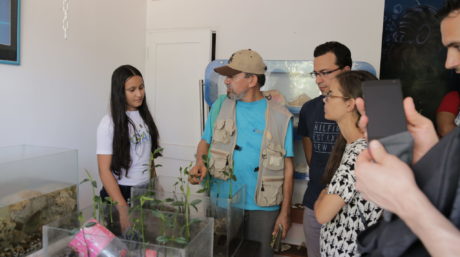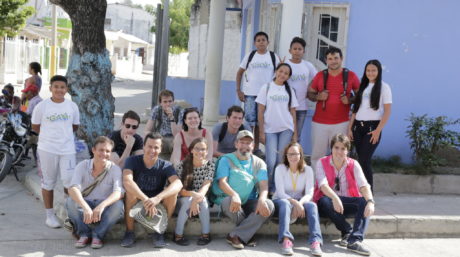
The Foundation Seeking to Protect the Mangroves of Cartagena
-
Peatland conservation and restoration
Julián Reingold, a young wetland supporter
Colombia is not only one of the countries holding more biodiversity on the planet, but also a nation in which social peace is closely linked with the protection of natural resources. The case of Cartagena, a city on the North-West coast, is particular not only for its architectural and natural beauty, but also due to its rich history. But despite having been declared a world heritage site by UNESCO in 1984, the city still reflects several socioenvironmental inequalities. In addition, a political crisis at the level of local government has left a record of ten mayors within a period of seven years, leading to a chaotic urban governance.
Luís Fernando Sánchez is a marine biologist and director of Fundación Planeta Azul Caribe (FUPAC), an NGO which began to look after the city’s mangrove forest in 2006 with projects such as ‘Sailing Through Cartagena’, ‘Fishing for Life’ and ‘School of Fishermen’. With this initiatives FUPAC seeks to promote the marine culture to people of all ages that lives or visits this Caribbean region, supporting his work on research, education and innovation.
Education of the youngest is vital for countering social inequalities and acknowledging the value of natural systems. The pilot project ‘Sailing Through Cartagena’ has as its beneficiaries approximately 78,000 inhabitants of the Juan Angola canal surroundings, a brackish water-channel with an urban mangrove forest that divides the city center, splitting Cartagena into two halves: the rich one, and the poorest with less opportunities.
“The methodology of the ‘Triad’ seeks to contribute to the improvement of environmental conditions in the Caribbean region, hence, elevate the life-standards of its people. We are convinced that natural resources, the so-called ‘commons’, should be available as a tool for social equality, a natural capital for the redistribution of the wealth that they produce,” explains Sánchez via Skype.
The ‘Triad’ is FUPAC’s method to achieve a cooperation triangle between the community, socially committed businesses and professionals aiming their efforts towards an specific ecological unit: the Natural System of the Urban Mangrove Forest located along the Juan Angola canal, symbol of this dual Cartagena.
FUPAC, as a foundation, holds three lines of work consisting on education of waste management for children to enhance the value of ecosystems and biodiversity; entrepreneurship to support local businesses and promote sustainable tourism, and participative planning to consolidate the institutionalisation that the city is lacking.
Due to the governance crisis Cartagena faces lack of trust and risk of corruption, which is why the appeal to a stronger institutional life in the city has proven worthy to spark the debate surrounding social inequality. So far, ‘Sailing Through Cartagena’ could be considered a successful project as to bringing awareness of the potential that this ecosystem has to become a Ramsar site, something which could provide for national action and international cooperation regarding the conservation and wise sustainable use of the forest resources. However, mangroves are still being chopped down.

Their long-term plan is to scale the pilot project in the Juan Angola canal to the rest of the estuaries and lagoons of the Cartagena wetlands system, and eventually expand it to other ecosystems: the mangrove forest in the area of Barpu, which also contains a dry-tropical forest:
“By aiming to expand our activities to new territories we wouldn’t be starting from scratch, as the Triad model – with its lines of action and strategies – has proven successful and compatible with the reality of Barú, and we could also link with other organisations already present there. In that way, we could contribute to consolidate networks and establishing new alliances in the region – in accordance with SDG 17. At the north of Cartagena other management challenges lay ahead, such as the Ciénaga de la Virgen mangrove forest, allowing for a city with conservation potential based on a carbon credit scheme, which would allow for Cartagena to move towards a new sustainable development”, explains the Director of FUPAC.
Carbon bonds represent a sustainable business strategy involving international stakeholders who fund the conservation projects in forests place in developing countries, and they are divided into green bonds – land forests and blue bonds – marine ecosystems such as mangroves, seagrasses and coral reefs, all receptors of CO2. These diverse carbon caption strategies are vital for addressing climate change and countering the effects of global warming. Although the carbon markets have been formally included in article 6 of the Paris Agreement, they represent the most controversial aspect of international negotiations, which failed at the last Conference of the Parties (COP25) in Madrid.
As for climate change mitigation, mangroves play a key role in regulating climate, as the trees and bushes – and the soil beneath them – act highly effective as carbon sinks. The latest special report of the IPCC on oceans and the cryosphere in a changing climate (2019) concluded that reducing the emissions is a vital step to climate change adaptation in the future, but also promoting education as tool to improve general awareness on the current climate crisis.

Martha Lucia Palacios Peñaranda, is an expert in Sea Sciences and member of the academic staff on Environmental Management at Universidad Autónoma de Occidente, Cali. Having participated of the MMM5 conference in 2019, one of the largests and most important summits of mangroves, she offers a general overview of the situation in Colombia, which will be hosting the following MMM6 summit in 2022:
“According to recent data, mangroves in Colombia represent 285,049 hectares, with 90,160 of them in the Caribbean shore, and the other 194,880 hectares spread across the Pacific. Although mangroves have been severely affected due to indiscriminate logging, poorly managed infrastructure plans and expansion of the urban frontier, we can currently see still many spots where mangrove forests develop plentifully and local populations live in harmony with the ecosystem. Among these, mangroves of the Pacific coast are considered the most developed in terms of size and volume of all the American Pacific.”
Cover Photo: Excursion through the Juan Angola canal, Cartagena. (Credits: Luis Fernando Sánchez Rubio)
